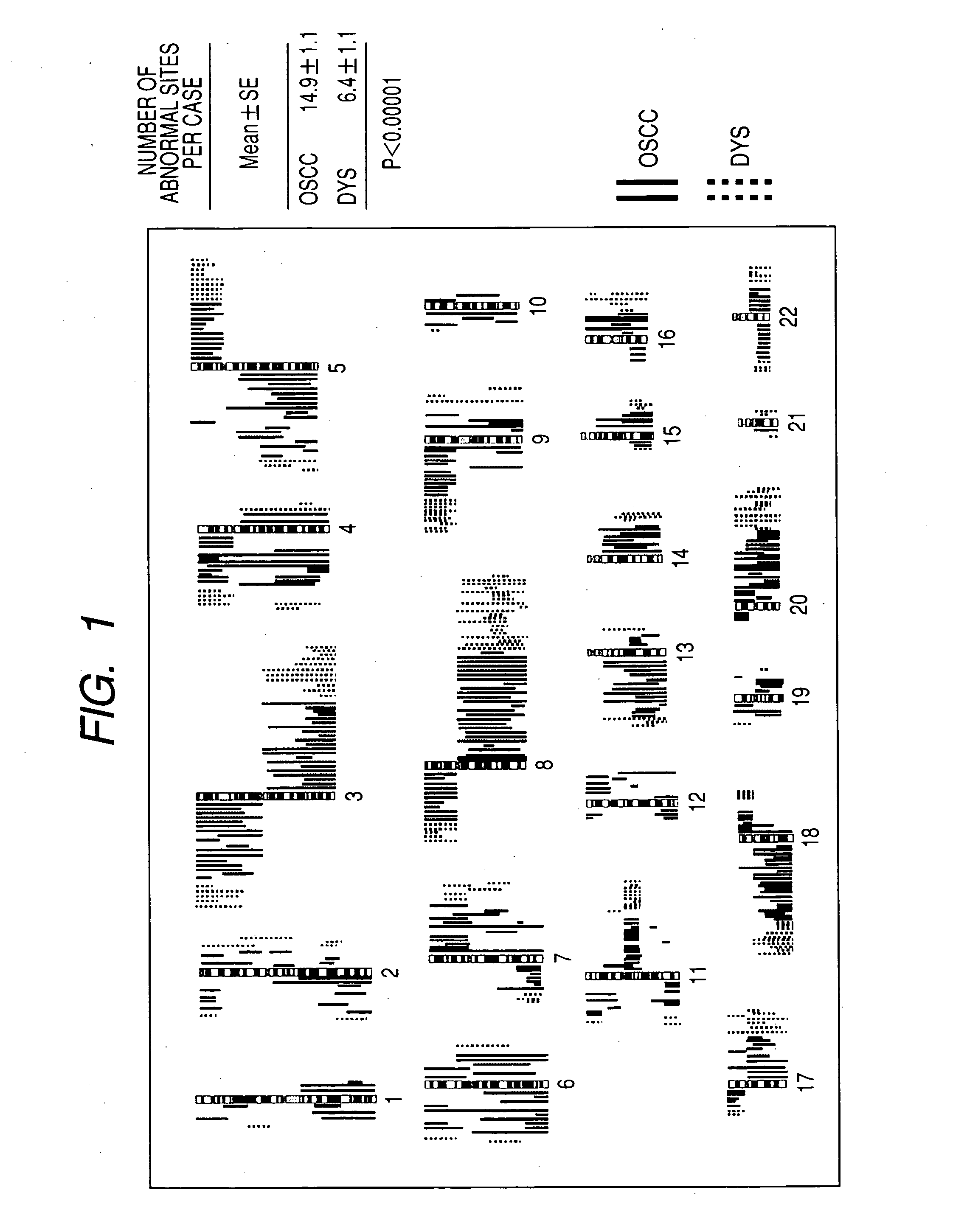Method for screening cells and method for detecting oral carcinoma cells
a cancer cell and cell technology, applied in the field of oral carcinoma cell screening, can solve the problems of not finding a method for early diagnosis of oral carcinoma, and it is almost impossible to evaluate the degree of cancer malignancy before starting treatment, and achieve the effect of high accuracy and effective method for evaluating the degree of cancer malignancy
- Summary
- Abstract
- Description
- Claims
- Application Information
AI Technical Summary
Benefits of technology
Problems solved by technology
Method used
Image
Examples
example 1
Screening of Cells by the CGH Method
[0056] To maximize the detection sensitivity of abnormality in the CGH method, samples were prepared by the microdissection method to collect cancer cells selectively.
[0057] In particular, biopsy samples were stored at −80° C., and tissue sections with 9 μm thickness were prepared. After staining with methyl green or hematoxylin-eosin, the tissue section was recovered as 15 μm spots by laser capture dissection and extracted with SepaGene Kit (Sanko Junyaku Co.) to obtain DNA.
2. DOP-PCR
[0058] DOP (degenerate oligonucleotide-primed)-PCR was carried out using a universal primer-6-MW (5′-CCGACTCGAGNNNNNNATGTGG-3′).
[0059] In particular, to 1 μl of DNA obtained by microdissection, 4 μl of sequenase buffer and 1 U of topoisomerase (Promega Co. Trade Mark, Madison, Wis.) were added and incubated at 37° C. for 30 min. Next, the reaction mixture was mixed with 20 U of Thermosequenase (Amersham Co. Trade Mark, Cleaveland, OH) and su...
example 2
Preparation of BAC Clone Microarrays
[0076] Slide glasses were washed and treated with aminosilane coupling agent according to the conventional method.
[0077] The clones corresponding to the chromosomal regions, which were determined to be useful for screening of oral carcinoma based on the result of the analysis in Example 1 (Table 1), were selected from the BAC clone library prepared by the conventional method. These clone solutions were injected into a 96 well microtiter plate and spotted on the slide grass with a DNA microarray apparatus. After standing at room temperature and fixing, the microarray was subjected to competitive hybridization reaction with DNAs of normal healthy people and samples labeled with different fluorescent dyes to obtain the ratio of copy numbers of DNAs of samples and normal healthy people. By defining the ratio of 1.2 or above as amplification and 0.8 or below as loss, the results obtained were almost the same as Example 1.
example 3
Preparation of the Back Clone Microarray with DNA of Normal Healthy People Fixed Beforehand
[0078] A back clone microarray was prepared as described in Example 2, and DNA of lymphocytes of normal healthy people, which was labeled with Spectrum Red, was fixed thereto by hybridization.
[0079] Sample DNA was labeled with Spectrum Green and hybridized with the microarray in which DNA of normal healthy people was already bound to back clones.
[0080] The red fluorescence of DNA of normal healthy people, which was originally bound to back clones, was replaced with the green fluorescence derived from the sample, and the ratios between the two were similar to those in Example 2.
PUM
| Property | Measurement | Unit |
|---|---|---|
| thickness | aaaaa | aaaaa |
| temperature | aaaaa | aaaaa |
| frequency | aaaaa | aaaaa |
Abstract
Description
Claims
Application Information
 Login to View More
Login to View More - R&D
- Intellectual Property
- Life Sciences
- Materials
- Tech Scout
- Unparalleled Data Quality
- Higher Quality Content
- 60% Fewer Hallucinations
Browse by: Latest US Patents, China's latest patents, Technical Efficacy Thesaurus, Application Domain, Technology Topic, Popular Technical Reports.
© 2025 PatSnap. All rights reserved.Legal|Privacy policy|Modern Slavery Act Transparency Statement|Sitemap|About US| Contact US: help@patsnap.com


